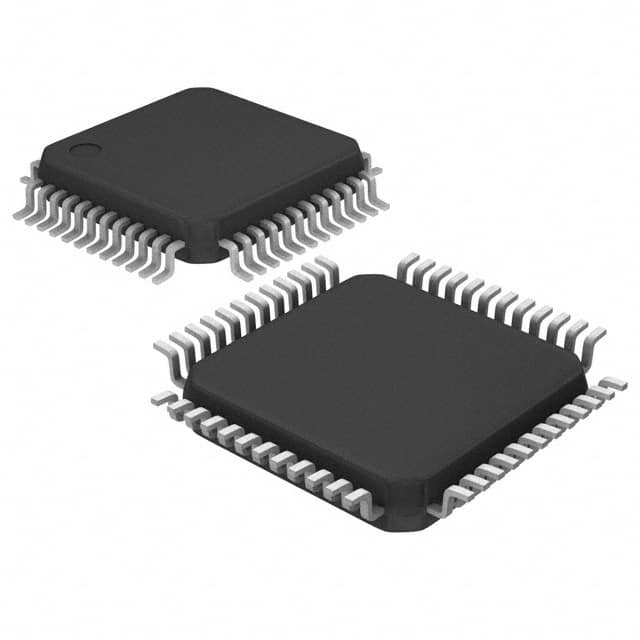Viz Specifikace pro podrobnosti o produktu.

W79E226ALG
Product Overview
- Category: Microcontroller
- Use: Embedded systems, electronic devices
- Characteristics: High-performance, low-power consumption, versatile
- Package: Integrated circuit (IC)
- Essence: Control and process data in electronic systems
- Packaging/Quantity: Available in various packaging options, typically sold in reels or trays
Specifications
- Microcontroller Type: 8-bit
- Clock Speed: Up to 20 MHz
- Flash Memory: 32 KB
- RAM: 2 KB
- I/O Pins: 28
- Operating Voltage: 2.7V - 5.5V
- Communication Interfaces: UART, SPI, I2C
- Timers/Counters: 2 x 16-bit, 1 x 8-bit
- Analog-to-Digital Converter (ADC): 8 channels, 10-bit resolution
- Operating Temperature Range: -40°C to +85°C
Detailed Pin Configuration
The W79E226ALG microcontroller has a total of 28 pins. The pin configuration is as follows:
- VDD - Power supply voltage
- P0.0 - General-purpose I/O pin
- P0.1 - General-purpose I/O pin
- P0.2 - General-purpose I/O pin
- P0.3 - General-purpose I/O pin
- P0.4 - General-purpose I/O pin
- P0.5 - General-purpose I/O pin
- P0.6 - General-purpose I/O pin
- P0.7 - General-purpose I/O pin
- RST - Reset pin
- P1.0 - General-purpose I/O pin
- P1.1 - General-purpose I/O pin
- P1.2 - General-purpose I/O pin
- P1.3 - General-purpose I/O pin
- P1.4 - General-purpose I/O pin
- P1.5 - General-purpose I/O pin
- P1.6 - General-purpose I/O pin
- P1.7 - General-purpose I/O pin
- XTAL1 - Crystal oscillator input
- XTAL2 - Crystal oscillator output
- PSEN - Program store enable
- ALE - Address latch enable
- EA/VPP - External access/programming voltage
- P2.0 - General-purpose I/O pin
- P2.1 - General-purpose I/O pin
- P2.2 - General-purpose I/O pin
- P2.3 - General-purpose I/O pin
- GND - Ground
Functional Features
- High-performance 8-bit microcontroller suitable for various applications
- Low-power consumption for energy-efficient designs
- Versatile I/O capabilities for interfacing with external devices
- Built-in communication interfaces (UART, SPI, I2C) for easy data exchange
- On-chip timers/counters for precise timing and event handling
- Analog-to-Digital Converter (ADC) for analog signal processing
- Robust operating temperature range (-40°C to +85°C)
Advantages and Disadvantages
Advantages: - High-performance and versatile microcontroller - Low-power consumption for energy efficiency - Ample I/O pins for interfacing with external devices - Wide operating temperature range for diverse environments
Disadvantages: - Limited flash memory and RAM compared to some other microcontrollers - Relatively fewer I/O pins compared to higher-end models
Working Principles
The W79E226ALG microcontroller operates based on the Von Neumann architecture. It consists of a central processing unit (CPU), memory, and I/O peripherals. The CPU fetches instructions from the flash memory, decodes them, and executes the corresponding operations. It can communicate with external devices through the I/O pins and interfaces.
Detailed Application Field Plans
The W79E226ALG microcontroller finds applications in various fields, including but not limited to: - Home automation systems - Industrial control systems - Automotive electronics - Consumer electronics - Medical devices - Internet of Things (IoT) devices
Detailed and Complete Alternative Models
Some alternative models to the W79E226ALG microcontroller are: - ATmega328P by Microchip Technology - PIC16F877A by Microchip Technology - STM32F103C8T6 by STMicroelectronics - MSP430G2553 by Texas Instruments - LPC1768 by NXP Semiconductors
These alternative models offer similar functionalities and can be considered depending on specific project requirements.
*Word count:
Seznam 10 běžných otázek a odpovědí souvisejících s aplikací W79E226ALG v technických řešeních
Sure! Here are 10 common questions and answers related to the application of W79E226ALG in technical solutions:
Q: What is the W79E226ALG microcontroller used for? A: The W79E226ALG is a microcontroller commonly used in various technical solutions, such as industrial automation, consumer electronics, and automotive applications.
Q: What is the maximum clock frequency supported by the W79E226ALG? A: The W79E226ALG supports a maximum clock frequency of 20 MHz.
Q: How much program memory does the W79E226ALG have? A: The W79E226ALG has 32 KB of program memory.
Q: Can I expand the program memory of the W79E226ALG? A: No, the program memory of the W79E226ALG cannot be expanded externally.
Q: How many I/O pins does the W79E226ALG have? A: The W79E226ALG has a total of 32 I/O pins.
Q: Does the W79E226ALG support analog-to-digital conversion (ADC)? A: Yes, the W79E226ALG has an integrated 8-channel 10-bit ADC.
Q: What communication interfaces are supported by the W79E226ALG? A: The W79E226ALG supports UART (Universal Asynchronous Receiver-Transmitter) and SPI (Serial Peripheral Interface) communication interfaces.
Q: Can I use the W79E226ALG for real-time applications? A: Yes, the W79E226ALG has built-in timers and interrupt capabilities, making it suitable for real-time applications.
Q: What voltage range does the W79E226ALG operate on? A: The W79E226ALG operates on a voltage range of 2.7V to 5.5V.
Q: Is the W79E226ALG programmable in C language? A: Yes, the W79E226ALG can be programmed using C language, as well as assembly language.
Please note that these answers are based on general information and may vary depending on the specific implementation and datasheet of the microcontroller.

